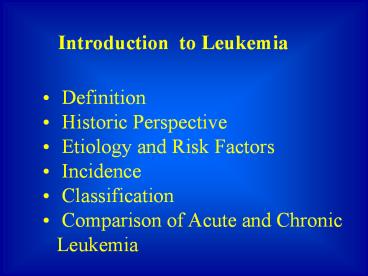Introduction to Leukemia - PowerPoint PPT Presentation
Title:
Introduction to Leukemia
Description:
Comparison of Acute and Chronic Leukemia Chronic bone marrow dysfunction Patients with CBMD syndromes have an increased risk of acute leukemic transformation. – PowerPoint PPT presentation
Number of Views:607
Avg rating:3.0/5.0
Title: Introduction to Leukemia
1
Introduction to Leukemia
- Definition
- Historic Perspective
- Etiology and Risk Factors
- Incidence
- Classification
- Comparison of Acute and Chronic Leukemia
2
Leukemia Definition Leukemia is a malignant
disease of hematopoietic tissue characterized by
the accumulation abnormal white cells (neoplastic
or leukemic) in the bone marrow leading to bone
marrow failure, a raised circulating white cell
count (leukocytosis) and infiltrate organs (e.g
liver, spleen, lymph nodes, brain)
3
- Leukemia
- Historic Perspective
- 1945
- The initial description of leukemia as a clinical
entity was made by Bennett in Scotland and in
Germany.
4
Leukemia
- Etiology and Risk Factors
- The etiology of leukemia is unknown.
- Oncogenes mutation and tumor suppressor gene
alteration. - Host factors.
- Environmental factors
5
Oncogene mutation Tumor suppressor
gene Chromosomal abnormality Gene rearrangement
Stem Cell
?
?
Myeloid series
Lymphoid series
?
?
Leukemia
6
- Host Factors
- Congenital chromosomal abnormalities
- Increased frequency in patients with congenital
disorders that have tendency for chromosomal
abnormality. - Such as Blooms syndrome, Fanconi anemia,
Downs and Klinefelters syndromes. - 18-20 fold increase incidence of AL is seen in
children win DS.
7
- Immunodeficiency
- An unusually high incidence of lymphoid leukemia
and lymphoma has been described in patients with
hereditary immunodeficiency states
(ataxia-telangiectasia and sex-linked
agamaglobulinemia). - Usually related to T and B-lymphocyte gene
rearrangement.
8
Chronic bone marrow dysfunction
- Patients with CBMD syndromes have an increased
risk of acute leukemic transformation. - Examples include the myelodypalstic syndromes,
myeloproliferative disorders, aplastic anemia and
PNH
9
Environmental factors
- Ionizing radiation
- Leukemia is associated with exposure to ionizing
radiation such as nuclear weapons in Hiroshima
and Nagasaki. - Both acute and chronic forms of leukemia
including AML, ALL and CML were associated.
10
Chemical drugs
- A variety of chemicals and drugs have been
associated with the development of leukemic
transformation - Examples Benzene, Chloramphenecol,
Phenylbutazone and Cytotoxic alkylating
chemotherapeutic agents.
11
Viruses
- The human T-cell leukemia-lymphoma virus-I
(HTLV-I) has been implicated as a causative agent
of adult T-Cell leukemia-lymphoma. - Another related virus HTLV-II has been isolated
from patients with atypical hairy cell leukemia
(CLL) - The Epsteins Barr virus has been linked to
Burkitts lymphoma.
12
Incidence
- In the USA 8-10 new cases per 100,000 individuals
annually. - Approximately 28,600 new cases were reported
about 50 acute and 50 chronic - Leukemia strike more in adult than children
(101) and has slightly increase incidence in
males than females (1-21)
13
Classification of leukemia
Main classification
Chronic leukemia
Acute leukemia
FAB
Lymphoid
Myeloid
Lymphoid
Myeloid
AML M0 M1 M2 M3 M4 M5 M6 M7
CML PV ET IMF
14
Comparison of acute and chronic leukemia
Acute Chronic
Age All ages Adults
Clinical onset Sudden Insidious
Leukemic cells Immature Mature
Anemia Mild to severe Mild
Thrombocytopenia Mild to severe Mild
WBC Variable Increased
Organomegaly Mild prominent































